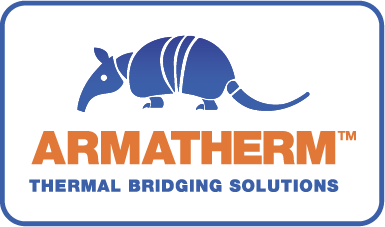
Armatherm
About us
We can manage thermal bridging issues in building designs from the foundation to the roof as a collaborating partner. To minimise energy loss inside buildings, we develop structural thermal breaks.
We have locations in the US, the UK, and the EU.
We ship globally through our network of agents.
We produce a wide variety of products using a variety of materials, each of which combines high compressive strength and low thermal conductivity. They were specifically created and tested to distribute load while avoiding thermal bridging.
Delivery should occur within five to ten business days.
We keep high stock levels of the most popular materials, and can provide these in sheet form and bespoke sizes.
Your delivery should arrive within five to ten business days.
We keep high stock levels of the most popular materials, and can provide these in sheet form and bespoke sizes.
You can expect delivery within five – ten business days.
GENERAL FAQs
Thermal Bridging
A section or component of an object that has a higher thermal conductivity than the materials around it is called a thermal bridge. Bypassing the insulating layer, the thermal bridge transfers unwanted heat from a heated area to the outside.
With the wall framing, particularly with steel wall studs, thermal bridging within walls can take place, allowing heat or cold air to escape.
There are substances that enter the building envelope from the insulation. They could form thermal bridges that let heat or cold air escape from a structure.
Thermal bridges can occur within several points during construction, any application where a conductive material is used is at risk of causing thermal bridges.
A conductive substance may be utilised in any application, which increases the possibility of thermal bridges developing at various points during construction.
Thermal bridging is also frequently referred to as cold bridging.
Any sort of thermal or cool bridges can be prevented with the use of the correct thermal break.
Thermal Breaks
Thermal Breaks
The full breakdown of each product’s values can be seen by downloading our datasheets here.
A thermal break is a material which benefits from low thermal conductivity properties to slow the flow of heat/ energy between thermal bridges.
A thermal break can be included within a construction project to make the building as energy efficient as possible. They can be used throughout the building envelope thanks to their strength and versatility.
Thermal bridges can occur within any application where a conductive material is used and temperatures can be transferred.
Masonry applications contain tie-backs and shelf angles which result in significant thermal bridges. Shelf angles transfer the masonry load back to the buildings’ structural steel or concrete slab edge interrupting the continuous insulation of the wall assembly creating a linear thermal bridge.
When a building frame directly meets with the foundation, significant heat loss can occur. By inserting a thermal break between the foundation and frame, energy can be saved.
Including thermal breaks within a construction improves the efficiency in areas which are traditionally difficult to insulate.
Armatherm’s products can save up to 70% of energy, depending on the application it’s used on.
By specifying a thermal break, 30-75% of energy can be saved in areas where thermal bridges occur.
Depending on the plan details, thermal breaks are usually 1 – 4″ thick.
Armatherm’s structural thermal breaks can bear loads between 230psi, and 43,000psi.
Applications/fitting
There are a range of applications which would benefit from a thermal break including cladding attachment, slab edges, doors and window penetrations, roof penetrations like HVAC equipment, davits, dunnage, balconies, canopies, parapets, column bases, foundations.
A wall that extends over the edge of a roof, balcony, terrace, walkway, or other building is called a parapet roof. It’s a short, vertical wall that runs the roofline of any building.
By including a thermal break, parapet transitions can be insulated. Parapets can be insulated where the roof and wall converge.
You can insulate a parapet wall from the roof by using a high strength, weight-bearing thermal break.
Using a high strength, weight bearing thermal break will insulate a parapet wall from the roof.
As a highly conductive metal which will transfer significant amounts of energy and heat from inside to outside, steel requires insulation to reduce heat transfer . Separating them with a thermal break can help prevent heat transfer.
Cast-in-situ high strength polyurethane insulation can thermally break concrete.
With the use of a thermal break energy and heat transfer can be reduced. This is important as steel balconies can be highly conductive.
It is possible to insulate concrete walls by using nonconductive Z Girt anchors.
Wood and rubber do have low thermal conductivity properties. However their tendency to deflect and creep make them less than ideal
Thermal breaks can be fitted within most applications that need a thermal isolation. Available in a range of different products to suit different applications, the fitting is bespoke to the application. Our team can advise on your specific needs.
As thermal breaks can alter the dimensions of a plan, therefore they need to be specified and included with any planning stages.
Washers and bushings are advised to maximise thermal performance of a thermal break. Armatherm can supply fixings for our FRR thermal breaks.
When a thermal break is inserted under a column, it is referred to as a ‘column break’. This reduces heat loss where the column meets the foundations.
A thermal break can be included on top of the footing and over the bolts and anchors with the column resting on top to thermally insulate the connection.
Roof-top HVAC equipment can be thermally broken at the base connection to the supporting beam.
To insulate roof-top anchors, we would normally advise Armatherm 500, although Armatherm FRR can also be specified within applications that require maximum strength.
Armatherm 500 is usually specified for insulating sill plates and mud sills.
By inserting a thermal break where the steel angle is bolted to the frame, a brick shelf can be thermally broken.
Other
If moisture gets into the wall assembly, rainscreen sliding allows for draining and drying.
The building’s façade has a continuous layer of insulation that lessens energy transfer between the structure and its surroundings.
Balconies, canopies, parapets, column bases, foundations, cladding attachment, slab edges, doors and window penetrations, roof penetrations like HVAC equipment, and davits are common places to find thermal breaks.
Continuous insulation prevents heat transfer in areas this is not required, meaning internal temperatures will stay warmer in cool weather and cooler in warm weather.
A thermal barrier and rainscreen barrier should work together.
The thermal conductivity of dense structural materials is usually poor.
Energy efficiency can be substantially increased with the addition of thermal breaks within the building. This will reduce thermal bridges and prevent the transfer of energy and temperatures.
Energy efficiency can be increased in a building with the addition of thermal breaks which reduce thermal bridges and prevent the transfer energy and temperatures.
Product specific
ArmaGirt™ Z Girts
A Z Girt is a S-shaped structural material that is used for holding insulation and mounting cladding or sliding. The non-conductive girts offer as much as a 75% improvement over traditional steel z girts.
Non conductive z girts provide secure insulation for continuous insulation, and a sound surface to connect cladding and siding.
A Z Girt may be shimmied if required.
Mineral wool and polyisocyanurate are the two insulating materials that are used with Z Girts the most frequently.
Z Girts may carry a variety of insulation and cladding thicknesses and are simple and quick to install. The insulation can function by specifying non-conductive Z Girts. the insulation to perform
ArmaGirt™ Z Girts come in seven standard sizes.
ArmaGirt™ Z Girts can hold all common insulation and all types of cladding except the heaviest.
ArmaGirt™ Z Girts can hold all common insulation and all types of cladding except the heaviest.
Use weather resistant screws to attach ArmaGirt™ Z Girts
FRR
Armatherm’s FRR material stands for ‘fabric reinforced resin’, it’s a compressed thermoset resin with impressive insulation properties.
FRR is best suited to be specified in projects with steel to steel connections where high compressive strength is needed.
FRR will be bolted between steel plates to control conductive heat loss or gain. FRR pads are often 1″-4″ thick.
FRR is tested at 300N/mm2 of compressive strength. A 305mm x 305mm steel pad with FRR could take over 6,000,000 pounds of compressive load.
The steel terminated and a plate is welded on, then a thermal break is sandwiched into a bolted connection as the steel continues outside the building. The thickness of the thermal break is dependant on the situation.
Armatherm’s FRR material can improve the efficiency of a building by reducing heat flow out of the envelope.
FRR is stocked in thicknesses from 1/16″ to 2″, but can be bonded to create custom thicknesses to suit whichever measurements you require.
Should be protected from fire and can be used in areas that are <175 degrees F.
Either, FRR can be drilled on site but Armatherm can provide custom cutting and drilling to make sure it’s sent to site at the correct measurements.
The bolt specs will be decided by the engineer.
Not at all, but they must be specified within the early stages of a project.
The spec of the bolts will be decided by the engineer.
Armatherm’s washers and bushings reduce the steel to steel contact to improve efficiency and reduce bridging.
500
The series ranges from 500-80, 230psi at R-3.85 to 500-280, 2150psi at R-1.9. The lower the compression strength, the higher the R-value will be.
The material used to make Armatherm 500 is extremely high density polyurethane.
The polyurethane used to make the 500 series is regarded as foam.
The 500 series can be utilised everywhere there is a penetration or transition in the building envelope, preventing thermal bridges from forming.
Armatherm 500 has amazing insulating values, is simple to install, and can be cut and drilled to shape.
The thicknesses can be bonded to any thickness and range from 1/2″ to 1″ to 2″.
Armatherm 500 comes in 4’X8′ sheets as standard, however it can be drilled and cut to bespoke sizes.
It is possible to cut and drill the 500 series on site. We would recommend using a Forstner style drill bit.
The 500 range can withstand 2n/mm2 to 18.5n/mm2.
When installed correctly, Armatherm’s 500 material will not crush over time.
The Armatherm 500 series ranges from 2n/mm2 to 18.5n/mm2 compressive strength. at R-4.6. The lower the compressive strength, the higher the R value will be.
